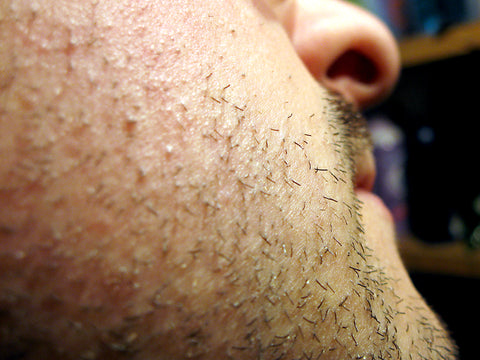Beyond The Suds
How To Prevent Ingrown Hairs and Razor Bumps With Traditional Wetshaving
by Carrie
Many men experience ingrown hairs or razor bumps while shaving. Medically known as "pseudofolliculitis barbae", this condition occurs when a hair grows out of the skin, curls around, and grows back in (razor bump) or the hair grows back after shaving but doesn't exit the follicle, getting trapped underneath the skin (ingrown hair). Either way....OUCH! In both situations, hairs that are lodged in the skin can cause inflammation and appear as tender, itchy, red, raised bumps (many times being mistaken for acne). And men with coarse or curly hair are more prone to dealing with the challenges of these wayward hairs.

That's the frustrating news. But the good news is that traditional wetshaving offers some easy steps you can take to prevent or reduce the incidences of ingrown hairs and razor bumps. And the doubly good news is that I'm into alliteration, so you just have to remember a few "S"s to get you on the right track.
(**Quick Note: The following recommendations apply specifically to shaving with Single Edge or Double Edge razors and may not be as applicable for Straight Razor users, especially the information pertaining to stretching the skin. As with most recommendations, your mileage may vary, depending on your specific skin and hair type.)
How to Prevent or Reduce Ingrown Hairs and Razor Bumps:
- SCRUB (lightly). Many men find that using a gently exfoliating scrub or cleanser helps to remove the dead layer of skin that can clog the hair follicles. Doing this seems to encourage hair growth in the right direction, while moisturizing the hair that is about to be shaved. (We'll be talking more about exfoliation in an upcoming blog post.)
- SOAK & SOFTEN. Wetting the beard with warm water for 2-5 minutes before shaving allows the hair to be more pliant and easier to cut than dry hair. If you shower first, this is an easy step that you're already doing. If you don't shower before shaving, try applying a warm, wet towel or washcloth to hydrate your skin and whiskers.
- SOAP (or cream). Choose a good quality shaving soap or cream that will provide plenty of cushion and glide, to make the razor pass more smoothly and also the create a more comfortable situation for inflamed skin. Allowing the shaving soap to sit on the skin for a little bit before shaving may also help to soften and moisturize the hair, further reducing friction and irritation.
- SHAVE SIMPLY. This isn't the place to get all fancy and try some new tricks. Simply go WITH the grain (WTG) of your hair growth and try to take fewer strokes. Additionally, allow the skin to remain in a neutral, relaxed position (no stretching...we'll explain why later on in this post). WTG, few strokes, and relaxed skin will reduce the chance of cutting the hair below the surface of the skin, which can lead to a greater risk of ingrown hairs.
- SPOIL YOUR SKIN. Immediately after shaving, be sure to rinse thoroughly, preferably with cold water. Following up with a good quality aftershave or moisturizer will help keep your skin healthy between shaves and better prepped for your next shaving session.
Two bonus "S"s regarding your blade:
- SHARP. Shave with a sharp blade. A dull blade doesn't cut as easily, meaning you'll be more tempted to go back over that area to try to get closer. It can also result in uneven tearing of the hair. Remember also to rinse the blade after each pass which helps remove skin and hair that gets caught in the blade. This creates a better set-up for smoother, less irritating shaving. Additionally, know when to throw the blade away, usually after 3-5 uses (depending on the blade).
- SINGLE. Stay away from multi-blade razors that can lift and cut hair below the natural, relaxed skin line.
And finally, why NOT to stretch the skin while shaving: Pulling or stretching the skin causes the hair to raise up (protrude) above the natural level of the skin. When the skin is released, hair can then "pop back" to below skin level. The skin then covers the hair, essentially trapping it underneath and not allowing it to grow easily out of the follicle. End result? Ingrown hairs.
(As a reminder, if you're looking for reputable products to use for Steps 3 & 5, we can point you in the right direction).
